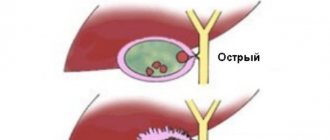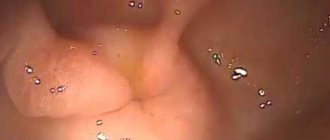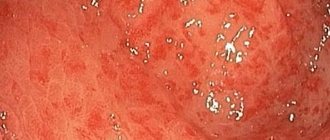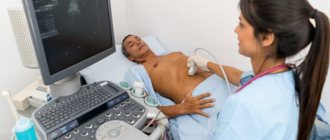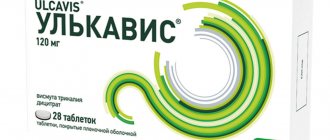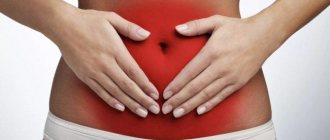According to statistics, it is this form of the disease that leads to ulcers in 80% of cases! The concept of “gastritis”, familiar to many, is very capacious and implies inflammation of the gastric mucosa.
But there are many varieties of this disease: the classification is based on the course of the process (acute or chronic gastritis), by localization, by morphology, and by the prevalence of the lesion. Next we talk about antral gastritis, because according to statistics, it is this form of the disease that leads to the development of ulcers in 80% of cases.
What is antral gastritis?
Superficial antral gastritis is localized in the lowest part of the stomach, which passes into the duodenum. This section produces the hormone gastrin, which powerfully stimulates acids. It is classified as hypersecretory gastritis because there is an increase in acidity.
Antral gastritis is a chronic superficial inflammation of the gastric mucosa. Until recently, it was believed that antral gastritis affects those who neglect a balanced diet, abuse alcohol, nicotine addiction, do not control caffeine consumption, and are also addicted to hot and sour spices and seasonings.
But recently, medicine has proven that the main cause of antral gastritis is the bacteria Helicobacter pylori. Their penetration into the mucous membrane leads to the development of inflammatory processes, increased secretion and acidity in the stomach.
Simply put, the acid-base balance of the antrum is disrupted. The mucus loses the viscosity necessary for processing food. The functioning of the glands is disrupted, so a person feels heartburn and heaviness.
We hasten to remind you that at the first symptoms of gastritis, it is necessary to urgently consult a specialist, otherwise the disease may acquire a degenerative-dystrophic form, which can cause scars to appear on the mucous membrane. This leads to the next, more serious stage - difficulty moving food into the intestines.
Causes
Menu for exacerbation of gastritis
Approximately 95% of all cases of chronic superficial antrum gastritis are caused by the detection of the bacterium Helicobacter pylori in the gastric mucosa.
This bacterium feels comfortable in gastric mucus with a pH of 4 to 6, however, even with increased acidity, the microorganism remains active.
A decrease in the acidity of gastric secretions is considered detrimental to bacteria. In an unfavorable environment, Helicobacter passes into the cyst stage, and when it gets into comfortable conditions, it becomes active again.
Helicobacter bacteria produce certain enzymes that cause changes in the composition of mucus. For example, urease breaks down the urea present in the stomach into ammonia, which contributes to the alkalization of the environment. The enzyme mucinase reduces the viscosity of gastric mucus, which facilitates the penetration of bacteria into the antral mucosa of the stomach.
In this area, it begins to actively multiply, which provokes damage to the mucous membrane and disruption of the functioning of the gastric glands. As a result of pathological changes in the gastric mucosa, bicarbonates cease to be produced, which causes a gradual increase in the acidity of gastric juice and additional damage to the gastric epithelium.
The development of Helicobacter pylori infection is facilitated by duodenogastric reflux, the use of certain medications, poor quality nutrition, and smoking. Sometimes the development of pathology can be promoted by certain internal agents, such as foci of chronic infection, endocrine dysfunction, anemia, cardiac and respiratory failure and chronic renal impairment.
Provoking factors
In addition to Helicobacter pylori infection, a variety of causes can lead to the development of non-atrophic gastritis. Experts conditionally divide them into two large groups – exogenous (external) and endogenous (internal). To begin with, let's highlight the provoking factors from the first category:
- irregular diet, as well as addiction to fatty and spicy foods. Consumption of low-quality food. Long breaks between meals;
- insufficient chewing of food, overeating, especially before bedtime;
- prolonged emotional shock, frequent stressful situations;
- uncontrolled use of medications that negatively affect the integrity of the mucous layer of the gastric pouch. These include non-steroidal anti-inflammatory drugs, salicylates, anti-tuberculosis drugs;
- harmful working conditions in which a person has to come into contact with acids and alkalis;
- influence of radiation;
- bad habits such as smoking and alcoholism.
Separately, I would like to highlight the role of Helicobacter pylori in the occurrence of the process. After the bacteria enters the body and comes into contact with the gastric epithelium, gastric cells are damaged. During the inflammatory reaction, epithelial cells are activated, which causes their secondary damage. As a result, the level of hydrochloric acid increases, and this negatively affects cell regeneration processes.
Endogenous factors include the following:
- complications after surgery;
- genetic predisposition;
- intoxication of the body;
- metabolic failures;
- fungal infection;
- endocrine disruptions;
- infectious processes;
- hypovitaminosis;
- HIV infection;
- parasites;
- diseases of the digestive tract;
- intolerance to certain foods;
- autoimmune processes.
Types of disease
Superficial gastritis of the antrum of the stomach develops gradually; there are two main stages:
- active or acute antral gastritis. During this period, the disease develops rapidly and is accompanied by characteristic symptoms;
- chronic antral gastritis of the stomach.
Superficial gastritis
At the first stage of development of the disease, only the upper layers of the mucous membrane are affected, there are no scars or ulcerative formations. Gradually, the mucous membrane becomes thinner, the production of hydrochloric acid decreases, and the necessary enzymes for digestion also become less.
Few people take the symptoms of the disease seriously at this stage. The discomfort is only superficial, so you can take the remedy from your home medicine cabinet. The disease is quite often accompanied by bulbitis.
With this disease, the duodenal bulb is affected. Too much gastric juice enters the intestines, causing bulbitis; untimely treatment threatens the development of erosive gastritis.
Antral gastritis of erosive nature
At a later stage of the disease, harmful bacteria Helicobacter pylori enters the body. On the mucous membrane you can notice small erosions, which will later become ulcerative formations.
Many experience periodic internal bleeding, which is released along with vomit and feces. If treatment for erosive antral gastritis is not started on time, death is possible.
Peptic ulcer is one of the complications of antral gastritis
Atrophic form of antral gastritis
Chronic gastritis, improper or absent treatment causes serious gastric failure. This stage is already considered precancerous.
Classification
The acute form of antral inflammation of the stomach is extremely rare. Most likely, it is asymptomatic, so it is detected by chance. The main changes are found in the chronic course of the disease.
According to the depth of the lesion, they are distinguished:
- Superficial - disorders are detected only in the outer layer of the mucosa, no scars are formed, glandular cells function normally, the symptoms of antral gastritis are not constantly expressed, responds well to treatment. A type of superficial form is catarrhal gastritis. It accompanies acute inflammation, which developed as a reaction to medications, severe nutritional disorders, and a single dose of alcohol. In this case, the entire mucous membrane is swollen, covered with pinpoint hemorrhages (erythematous subtype).
- Erosive - inflammation rushes into the deeper layers, forms erosions, cracks, ulcers with subsequent formation of scars. It is much more difficult to treat. The main symptoms are more pronounced and severe. Signs of hidden or obvious bleeding are determined in the stool; streaks of blood are detected during vomiting.
The emergence of a fibrogastroscopic diagnostic method has made it possible to distinguish different types of gastritis
By prevalence we can distinguish:
- focal lesion - fibrogastroscopy shows an alternation of inflamed areas and normal tissue;
- diffuse - starts from the antrum and spreads to the entire stomach, the process of inflammation disrupts the digestion of food, the resulting toxic substances affect the entire body (temperature rises, weakness, nausea occur).
According to the degree of violation of secreting properties, we can distinguish:
- Atrophic gastritis - caused by the gradual loss of the gastric mucosa's ability to produce acid, mucus, and protective hormones. Cells die and the stomach wall becomes thinner. Some researchers distinguish a subatrophic stage with moderate dysfunction.
- Hyperplastic - is a variant of atrophic changes. The folds of the mucous membrane become large, forming cysts and small polyps. They are formed due to intensive proliferation (growth) of epithelial cells of the antrum. There are no specific symptoms.
Rare forms
Some variants of the disease are quite rare and do not differ symptomatically from the previous ones. The diagnosis is made only on the basis of fibrogastroscopic signs.
- Follicular gastritis is a rare form of antral inflammation, as it is associated with an immune reaction. Lymphocytes accumulate in the affected areas and form blisters. They clog the outlets of the glands that produce bicarbonates (alkalizing substances to maintain acidity levels). Therefore, the acidity of the juice remains high for a long time.
- Granular - small protrusions (no more than cm in diameter) form on the mucous membrane due to local growths.
- Hemorrhagic - regarded as an unfavorable consequence of the erosive form. Clinical manifestations include vomiting blood and black loose stools, which can be considered signs of bleeding.
- In severe cases, antral rigid gastritis may develop. Characteristic is the transformation of the stomach wall into massive sclerotic areas. Scarring leads to a significant narrowing of the entire pyloric region. The variant has an unfavorable prognosis - up to 40% of cases transform into a malignant tumor.
Symptoms of antral gastritis
The clinical picture is visible in the acute form of the disease. There are local, local signs (relating specifically to the stomach) and general ones. Local signs include:
- Gastric dyspepsia - spasmodic pain and a burning sensation in the epigastrium, belching, nausea, heartburn, sour taste in the mouth, lack of appetite.
- Intestinal dyspepsia - unstable stool: constipation or laxity, rumbling, bloating. Before eating or after a painful attack, 1-3 hours.
General signs:
- weakness,
- irritability,
- arrhythmia,
- hypertension,
- cardialgia,
- heaviness under the left rib,
- fever, chills,
- weakness due to intoxication, etc.
Note: The acute phase is often confused with poisoning, but unlike the second, gastritis will linger for a longer time. This is why it is so important to consult a specialist for any symptoms and not prescribe self-medication.
Helicobacter pylory, stomach cancer, MALTOMA
Other areas of active interest in HP relate to the pathogenesis of gastric cancer and gastric B-cell lymphoma (MALToma). Helicobacter gastritis is the initial stage leading to gastric carcinoma in some patients, but other factors (environmental, genetic) must be involved before malignant growth begins. Based on four series of studies, the attributable risk for H. pylori in noncardiac gastric carcinoma was estimated to be 38% to 79% (Bret Lashner, MD, personal communication, 1995)
. The attributable risk reflects the number of cases of gastric carcinoma that could be eliminated if the infection were prevented by a vaccine. Many patients with low-grade gastric MALToma have H. Pylori and its irradiation is associated with “partial” or almost complete regression of the tumor. The persistence of this regression remains to be determined, but the relationship between this infection and lymphoma is of interest. The initial approach to gastric lymphoma, if it is low-grade and localized, is to determine by biopsy whether HP is present, administer radiation therapy and then follow-up with multiple endoscopies and biopsies, preferably in combination with endoscopic ultrasound.
Diagnostics
During gastrography with contrast in patients with antral gastritis, thickening of the relief folds in the pyloric region, spasm of the pylorus, segmented peristalsis, and disordered evacuation of gastric contents are noted.
With FEGDS, spotty hyperemia of the mucous membrane, swelling of tissues in the antrum are visible, hemorrhages and erosions can be detected. There is increased exudation and stagnation of contents in the stomach due to spasm of the pylorus.
During an endoscopic examination, a tissue biopsy is necessarily performed for histological examination and isolation of the pathogen. In this case, pronounced inflammation and a large number of Helicobacter on the surface of the epithelium are histologically determined.
The urease test for the determination of Helicobacter is carried out using special express kits during esophagogastroscopy. To do this, a mucosal biopsy is placed in a special medium, which changes its color depending on the concentration of microorganisms to crimson - from an hour to a day.
If the color does not change within 24 hours, the test is negative. There is also a C-urease Helicobacter test. To carry it out, C13-labeled urea is injected into the stomach, and then the concentration of C13 is determined in the exhaled air.
If there are Helicobacter bacteria in the stomach, they will destroy urea, and the concentration of C13 will be above 1% (3.5% - mild invasion, 9.5% - extremely severe). Mucosal biopsies must be cultured and incubated at extremely low oxygen concentrations (less than 5%) on blood media.
The result of culture with sensitivity to antibiotics will be obtained within 3-5 days. ELISA is a fairly sensitive method for detecting antibodies to Helicobacter in blood, saliva and gastric juice. Antibodies appear in the blood within a month after infection and remain active for a month after complete recovery.
To determine the acidity of gastric juice, a fractional study of gastric juice using secretion stimulants is used. The disease is differentiated from functional disorders, gastric ulcer.
Fully or partially limited products
- Avoid eating onions, garlic, lettuce, citrus juices, tomatoes, cranberries, turnips, radishes, rutabaga, radishes, ginger, mushrooms, and peeled fruits.
- Vegetables that cause gas formation are excluded: peas, white cabbage, beans, chickpeas, mung beans, grapes, raisins. For these reasons, it is better to avoid eating cabbage soup, okroshka and borscht. Also be careful when consuming foods that can increase gas formation - fresh yeast baked goods, rye bread, kvass, beer, carbonated drinks.
- Any fried foods, pickled, pickled and salted vegetables, hot seasonings, broths, smoked meats and sausages, coffee, tea, alcohol, carbonated drinks - they all increase the secretion of gastric juice.
- Meat and fish with rough connective tissue.
- Fatty fish, fatty meat, goose, any canned food, duck, lamb.
- Fried and hard-boiled eggs as they are difficult to digest.
- Do not include millet, barley, pearl barley and corn porridge and pasta in your diet.
- Animal fats and margarine, baked goods with margarine.
- Tomato sauce, horseradish, mustard, pepper and other seasonings, as they irritate the mucous membranes.
- Fermented milk products with high acidity.
- Sour fruits and berries, which can additionally increase acidity and cause discomfort and heartburn.
- Chocolate, alcohol, coffee and strong tea, ice cream.
- Butter and puff pastry.
Table of prohibited products
| Proteins, g | Fats, g | Carbohydrates, g | Calories, kcal | |
Vegetables and greens | ||||
| vegetables legumes | 9,1 | 1,6 | 27,0 | 168 |
| swede | 1,2 | 0,1 | 7,7 | 37 |
| cabbage | 1,8 | 0,1 | 4,7 | 27 |
| sauerkraut | 1,8 | 0,1 | 4,4 | 19 |
| green onion | 1,3 | 0,0 | 4,6 | 19 |
| bulb onions | 1,4 | 0,0 | 10,4 | 41 |
| cucumbers | 0,8 | 0,1 | 2,8 | 15 |
| canned cucumbers | 2,8 | 0,0 | 1,3 | 16 |
| white radish | 1,4 | 0,0 | 4,1 | 21 |
| turnip | 1,5 | 0,1 | 6,2 | 30 |
| canned tomatoes | 1,1 | 0,1 | 3,5 | 20 |
| horseradish | 3,2 | 0,4 | 10,5 | 56 |
| spinach | 2,9 | 0,3 | 2,0 | 22 |
| sorrel | 1,5 | 0,3 | 2,9 | 19 |
Mushrooms | ||||
| mushrooms | 3,5 | 2,0 | 2,5 | 30 |
Cereals and porridges | ||||
| corn grits | 8,3 | 1,2 | 75,0 | 337 |
| pearl barley | 9,3 | 1,1 | 73,7 | 320 |
| millet cereal | 11,5 | 3,3 | 69,3 | 348 |
| barley grits | 10,4 | 1,3 | 66,3 | 324 |
Confectionery | ||||
| candies | 4,3 | 19,8 | 67,5 | 453 |
Ice cream | ||||
| ice cream | 3,7 | 6,9 | 22,1 | 189 |
Cakes | ||||
| cake | 4,4 | 23,4 | 45,2 | 407 |
Raw materials and seasonings | ||||
| mustard | 5,7 | 6,4 | 22,0 | 162 |
| ginger | 1,8 | 0,8 | 15,8 | 80 |
| ketchup | 1,8 | 1,0 | 22,2 | 93 |
| mayonnaise | 2,4 | 67,0 | 3,9 | 627 |
| ground black pepper | 10,4 | 3,3 | 38,7 | 251 |
| chilli | 2,0 | 0,2 | 9,5 | 40 |
Meat products | ||||
| pork | 16,0 | 21,6 | 0,0 | 259 |
| ham | 22,6 | 20,9 | 0,0 | 279 |
Sausages | ||||
| dry-cured sausage | 24,1 | 38,3 | 1,0 | 455 |
| sausages | 10,1 | 31,6 | 1,9 | 332 |
| sausages | 12,3 | 25,3 | 0,0 | 277 |
Bird | ||||
| smoked chicken | 27,5 | 8,2 | 0,0 | 184 |
| duck | 16,5 | 61,2 | 0,0 | 346 |
| smoked duck | 19,0 | 28,4 | 0,0 | 337 |
| goose | 16,1 | 33,3 | 0,0 | 364 |
Fish and seafood | ||||
| dried fish | 17,5 | 4,6 | 0,0 | 139 |
| smoked fish | 26,8 | 9,9 | 0,0 | 196 |
| canned fish | 17,5 | 2,0 | 0,0 | 88 |
Oils and fats | ||||
| animal fat | 0,0 | 99,7 | 0,0 | 897 |
| cooking fat | 0,0 | 99,7 | 0,0 | 897 |
Non-alcoholic drinks | ||||
| bread kvass | 0,2 | 0,0 | 5,2 | 27 |
| * data is per 100 g of product | ||||
Nutrition
Diet therapy is the first and most important condition for proper treatment. Firstly, it is necessary to exclude foods that irritate the gastric mucosa, namely: salty, smoked, spicy and pickled foods, as well as hot foods. Secondly, meals should be fractional, 5-6 times a day.
A comprehensive treatment must be prescribed by a doctor. As a rule, the list of medications includes painkillers, antisecretory and anti-inflammatory drugs. But chronic superficial gastritis also requires a complete lifestyle change. Dietary nutrition is the main component of treatment. Food should be crushed, and its temperature should be close to body temperature.
Patients should create a menu based on these products:
- boiled or steamed meat;
- crushed fruits and fruit juices;
- pureed vegetables;
- low-fat fish;
- low-fat cottage cheese and milk;
- rice, semolina, oatmeal.
Spicy and salty foods, meat broths and raw coarse vegetables are excluded from the daily diet. Products with a lot of spices, preservatives and flavor enhancers are bypassed by the tenth road.
| Monday | Tuesday | Wednesday | Thursday | Friday | Saturday | Sunday |
| Breakfast – oatmeal porridge with water | Breakfast – buckwheat porridge on water | Breakfast – semolina porridge cooked in water | Breakfast – rice porridge cooked in water | Breakfast – oatmeal with water | Breakfast – poached eggs, cabbage salad, tea without sugar | Breakfast – buckwheat porridge boiled in water |
| Snack – poached egg | Snack – omelet | Snack – a glass of kefir | Snack – baked apple | Snack – low-fat kefir | Snack – a glass of carrot juice | Snack – poached egg |
| Lunch – low-fat steamed fish cutlets, pasta | Lunch – boiled rabbit soufflé, pumpkin puree | Lunch – boiled turkey breast, rice porridge on water | Lunch – boiled chicken breast, vegetable puree (broccoli, carrots, zucchini) | Lunch – steamed fish cutlets, mashed potatoes on water | Lunch – boiled rabbit meat soufflé, pasta | Lunch – boiled river fish, rice |
| Snack – peach puree | Snack – baked apple | Snack – poached egg, hard bread | Snack – low-fat yogurt | Snack – banana puree, low-fat cottage cheese | Snack – baked apple | Snack – grated carrots with sour cream |
| Dinner – boiled river fish, rice | Dinner – steamed fish cutlets with potatoes | Dinner – vegetable puree and boiled chicken breast | Dinner – boiled rabbit soufflé, pasta | Dinner – rice porridge on water, boiled turkey breast | Dinner – low-fat fish cutlets, pasta | Dinner – pumpkin puree, rabbit meat soufflé |
Only 15% of patients seek medical help for antral gastritis on time, since it does not have pronounced symptoms. The antrum is located near the entrance to the intestine, so superficial antral gastritis contributes to the formation of ulcers of the duodenum and stomach. This gastritis is caused by the bacterium Helicobacter pylori. For this reason, antibiotic therapy cannot be avoided.
Note: After recovery, you need to be regularly examined by a doctor to prevent relapse of the disease. A gentle diet will help reduce the risk of recurrent disease.
Reviews and results
Recently, there has been a shift away from the need for strict adherence to dietary nutrition for gastritis. Patients themselves feel the need for it during an exacerbation and exclude those foods that provoke pain. This diet option has been significantly expanded in terms of products and processing methods. This makes it possible to eat a varied and healthy diet, and the complete composition of the main substances allows you to stay on this therapeutic diet for a long time. Reviews from patients indicate its positive effect not only on the condition of the stomach, but also the intestines and pancreas.
- “... My stomach was constantly bothering me, though not much, but it didn’t let me forget about myself for a day. All this forced me to do a gastroscopy - catarrhal gastritis of the antrum, CB was not detected. At least it’s good that you don’t need to take antibiotics. Diet without treatment did not help, and the doctor prescribed the minimum: bismuth preparation, Nolpaza and chamomile decoction. At first, eating tasteless soup and steamed cutlets seemed difficult, but I definitely made it through the month. I love milk porridge, and I cooked it morning and evening - it’s always fresh. It included cottage cheese, milk, mashed potatoes not only from potatoes, but also from zucchini and unsweetened pumpkin. I noticed that along with the disappearance of stomach pain, constipation and heartburn went away. It’s not possible to be on such a diet all the time, but I definitely don’t eat spicy foods, pickles, pickled vegetables (and in general anything that contains vinegar), which are very fatty. I limit fried foods."
- “... From my own experience, I know that eating according to the clock, excluding provoking foods and dishes (for me, garlic, radishes, radishes, onions, ketchup, mayonnaise, mustard even in minimal quantities, ginger, pepper in dishes). Therefore, I exclude all this. Fried and sour foods do not cause pain, but after it there is belching and heartburn. Three years ago, the doctor told me to stick to proper nutrition all the time (you can only treat yourself on holidays), so I do everything. I feel good thanks to this and the prophylactic use of De-nol in the spring, when exacerbations are more common. The diet has determined itself over the years, as more and more foods are included in the list of poorly tolerated foods. A constant diet, including soups, boiled meat and fish, cereals and stewed vegetables, affected the weight. Without doing anything, I am gradually losing weight - 4-5 kg in a year. It’s not much, but it’s also good.”
- “... For six months I have been bothered by pain in the stomach, burning, belching and periodically heartburn and bloating. If you lie down after eating, the pain calms down a little. I finally decided to get examined. Gastritis and small erosions in the antal part were revealed. The Helicobacter smear was “++”, which means weakly positive, so no special antibiotics were prescribed, but only De-nol and Pantoprazole for 3 weeks. After 2 weeks, all unpleasant sensations disappear. A mandatory diet is to exclude everything spicy, fried, dry food, fresh vegetables and fruits. He ate light soups, porridges, boiled chicken and fish. I finished the treatment after 3 weeks, and adhered to proper nutrition for a total of 2.5 months. I got used to it, and it didn’t seem complicated. The only negative is that it’s difficult to combine such food with work or business trips.”
Treatment of antral gastritis
This pathology is treated by gastroenterologists, therapists, and endoscopists; during exacerbations, the patient is in the gastroenterology or therapy department. Treatment of antral gastritis begins with the appointment of a special therapeutic diet: during an exacerbation, table 1b with a gradual expansion to the first table over several weeks or months.
Anti-Helicobacter drugs are required. Etiotropic therapy for H. pylori is quite complex, since this microorganism quickly adapts to popular antibiotics. Most often, a double or triple treatment regimen is prescribed, which includes metronidazole, clarithromycin, ampicillin or tetracycline.
It is recommended to add proton pump inhibitors to the regimen, which inhibit Helicobacter, and use antibacterial drugs to completely eradicate them. Anti-inflammatory therapy can be carried out using both pharmaceutical drugs and herbs according to traditional medicine recipes.
So, during an exacerbation, it is recommended to use infusions of chamomile, mint, St. John's wort, and flax seeds. When erosions appear on the mucous membrane of the antrum of the stomach, or increased acidity of gastric juice, antisecretory agents are prescribed. For spasms of the pylorus, myotropic antispasmodics are successfully used: drotaverine, papaverine.
Metoclopramide is used to normalize peristalsis and eliminate duodenogastric reflux. The condition for complete recovery is the administration of reparative agents. These could be drugs that stimulate protein synthesis (inosine, anabolic steroids), carnitine, sea buckthorn oil.
Physiotherapy also occupies an important place: galvanization of the stomach with electrophoresis of drugs (for pyloric spasm), UHF therapy, ultrasound treatment (for analgesic purposes), diodynamic Bernard currents, sinusoidal modulated currents (to eliminate pain and dyspepsia). After stopping the exacerbation, mud and paraffin therapy and treatment with mineral waters are recommended.

